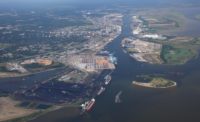China’s state-owned companies are close to completing construction of the country’s first offshore nuclear reactor. The first reactor will be soon deployed at drilling platforms in the Bohai Sea in northern China. Analysts expect future reactors wwould be sited on islands engineered and constructed by China in the South China Sea. The Spratly Islands have been a source of contention with other countries in the region.
Speaking at a recent industry meeting, Zhang Nailiang, an engineer with the China Shipbuilding Industry Corp., said the nuclear technology has matured and the company is ready to put up the first demonstration project in the Bohai Sea.
“We are confident we should be able to get it finished very soon,” he said, without giving an exact date for commissioning. It has been developed by a a research team backed by China Shipbuilding, China National Offshore Oil Corp. (CNOOC) and two reactor builders, China National Nuclear Corp. (CNNC) and China General Nuclear Power (CGN).
China regards the peaceful use of nuclear power as a strategic industry to advance the country’s international influence, and also create a market for Chinese reactors.
“We in the nuclear and shipbuilding industries have a call of duty to construct a ‘strong maritime power’,” Zhang said.
Floating reactors are an essential part of the country’s political goal of expanding its maritime presence as suggested by President Xi Jinping, Zhang said.
Two other developments reveal the extent of advance preparations by Beijing to produce nuclear power offshore and bolster its South China Sea initiatives in the face of similar territorial claims by Vietnam, Indonesia, Malaysia, Brunei and the Philippines.
CGN announced last August that it was creating a new company with a capital base of $150 million along with four other companies: Shanghai Electric, Shanghai Guosheng Group, Zhajiang Zheneng Electric Power and Jiangnan Shipyard. The new joint venture will work towards the development of floating reactors mounted on vessels that would float in the South China Sea and other seas.
Experts warn that floating reactors can intensify the process of militarization of disputed waters, and be very difficult to monitor. “The problem is the remoteness raises all kinds of questions about security, safety, economics, and logistics,” said Mark Hibbs, senior fellow of the Nuclear Policy Program at the Carnegie Endowment for International Peace.
“The big picture is that the Chinese see nuclear energy as a very strategic technology and as something that China will deploy to its strategic benefit,” he added.
On Nov. 3, China floated a dredging vessel capable building islands similar to one constructed already in the South China Sea, but at an accelerated pace. The 140-meter-long vessel, which the Chinese media has dubbed, “magic island maker,” can dredge 6,000 cubic meters an hour while from a depth of 35 m.
The vessel can also be used to dredge deepwater ports that China is developing in the Indian Ocean and the Middle East regions
China claims to have created a reactor which is meltdown proof, a technology which even the U.S. is yet to fully master. This is a crucial development for a country, which has as many as 20 power plants under construction, more than any other country. The new reactor, regarded to be the most advanced, has been established in Sanmen county of Zhejiang province next to the East China Sea.
The new reactor is based on the AP1000 technology, which “is a simple, genius solution to reduce the risk of nuclear meltdown,” said Xi’an Jiaotong University’s nuclear science professor Shan Jianqiang. Shan, who has authored university texts on reactor safety and operation, said that the commencement of Sanmen “can be a shot to the arm for the nuclear industry, which has been mired in trouble at home and abroad.”
Designed and made by Toshiba Corp.’s Westinghouse Electric subsidiary, the AP1000 uses an overhead water tank that keeps the reactor cool even in the case of a blackout.
At present, China has 37 reactors with a capacity of 32.4 GW. Beijing’s plan is to raise capacity to 58 GW by 2020 using 20 reactors that are under construction.
Nuclear power contribute 2% to the country’s energy mix. The National Development and Reform Commission has planned to it to 6% by 2020. At present, China is fourth in the world in terms of capacity and third by way of nuclear power generated.
China is also engaged in the development of nuclear fusion research with ITER (International Thermonuclear Experimental Reactor), an international megaproject, which aims to make the transition from experimental studies of plasma physics to full-scale electricity-producing fusion power stations.


